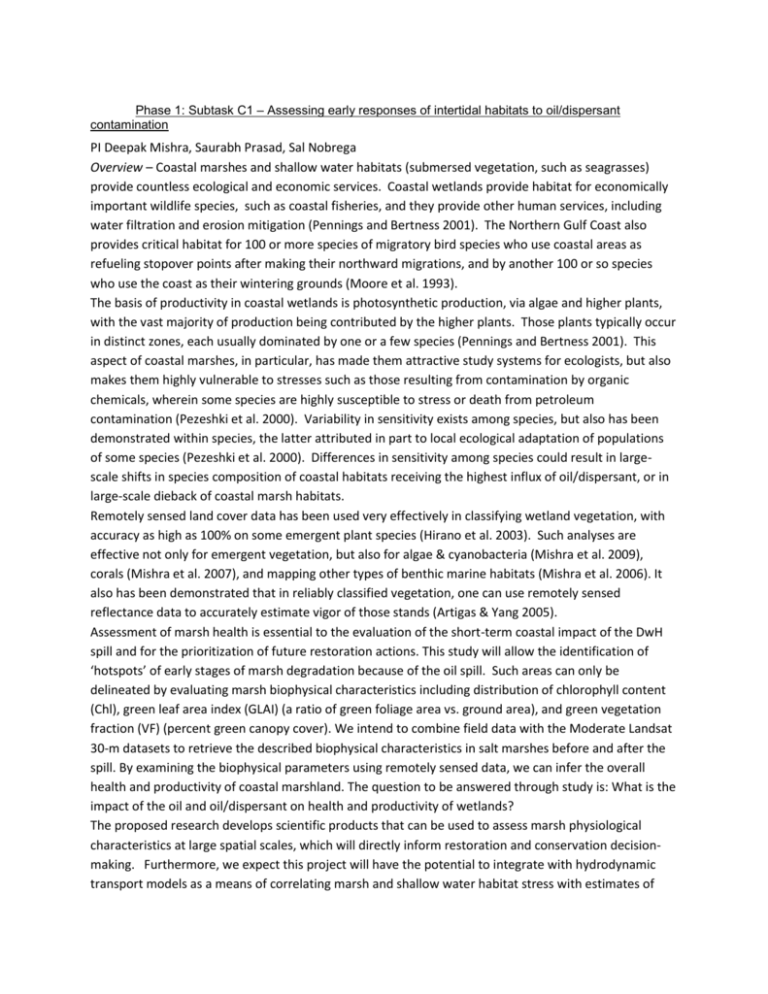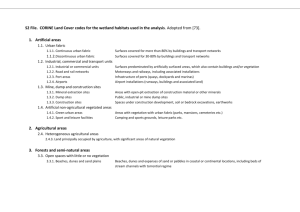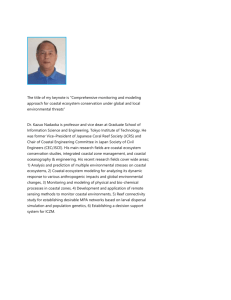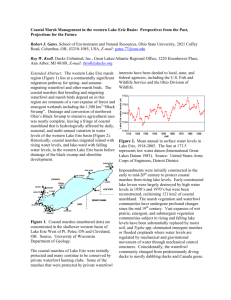COU Intertidal Habitats Mishra
advertisement

Phase 1: Subtask C1 – Assessing early responses of intertidal habitats to oil/dispersant contamination PI Deepak Mishra, Saurabh Prasad, Sal Nobrega Overview – Coastal marshes and shallow water habitats (submersed vegetation, such as seagrasses) provide countless ecological and economic services. Coastal wetlands provide habitat for economically important wildlife species, such as coastal fisheries, and they provide other human services, including water filtration and erosion mitigation (Pennings and Bertness 2001). The Northern Gulf Coast also provides critical habitat for 100 or more species of migratory bird species who use coastal areas as refueling stopover points after making their northward migrations, and by another 100 or so species who use the coast as their wintering grounds (Moore et al. 1993). The basis of productivity in coastal wetlands is photosynthetic production, via algae and higher plants, with the vast majority of production being contributed by the higher plants. Those plants typically occur in distinct zones, each usually dominated by one or a few species (Pennings and Bertness 2001). This aspect of coastal marshes, in particular, has made them attractive study systems for ecologists, but also makes them highly vulnerable to stresses such as those resulting from contamination by organic chemicals, wherein some species are highly susceptible to stress or death from petroleum contamination (Pezeshki et al. 2000). Variability in sensitivity exists among species, but also has been demonstrated within species, the latter attributed in part to local ecological adaptation of populations of some species (Pezeshki et al. 2000). Differences in sensitivity among species could result in largescale shifts in species composition of coastal habitats receiving the highest influx of oil/dispersant, or in large-scale dieback of coastal marsh habitats. Remotely sensed land cover data has been used very effectively in classifying wetland vegetation, with accuracy as high as 100% on some emergent plant species (Hirano et al. 2003). Such analyses are effective not only for emergent vegetation, but also for algae & cyanobacteria (Mishra et al. 2009), corals (Mishra et al. 2007), and mapping other types of benthic marine habitats (Mishra et al. 2006). It also has been demonstrated that in reliably classified vegetation, one can use remotely sensed reflectance data to accurately estimate vigor of those stands (Artigas & Yang 2005). Assessment of marsh health is essential to the evaluation of the short-term coastal impact of the DwH spill and for the prioritization of future restoration actions. This study will allow the identification of ‘hotspots’ of early stages of marsh degradation because of the oil spill. Such areas can only be delineated by evaluating marsh biophysical characteristics including distribution of chlorophyll content (Chl), green leaf area index (GLAI) (a ratio of green foliage area vs. ground area), and green vegetation fraction (VF) (percent green canopy cover). We intend to combine field data with the Moderate Landsat 30-m datasets to retrieve the described biophysical characteristics in salt marshes before and after the spill. By examining the biophysical parameters using remotely sensed data, we can infer the overall health and productivity of coastal marshland. The question to be answered through study is: What is the impact of the oil and oil/dispersant on health and productivity of wetlands? The proposed research develops scientific products that can be used to assess marsh physiological characteristics at large spatial scales, which will directly inform restoration and conservation decisionmaking. Furthermore, we expect this project will have the potential to integrate with hydrodynamic transport models as a means of correlating marsh and shallow water habitat stress with estimates of oil/dispersant loading rates along the Northern Gulf Coast. We also anticipate that results from this research will enable estimation of wildlife habitat loss and degradation for coastal fish, shellfish, birds, and other economically and culturally important species. Approach – We plan to employ cutting edge hyperspectral and/or multispectral imagery products to visualize and detect stress induced in sensitive estuarine vegetation. We intend to combine field data with the Moderate Landsat 30-m datasets to retrieve the biophysical characteristics (Chl, GLAI, VF) in salt marshes before and after the DwH spill. By examining the biophysical parameters using remotely sensed data, we can infer the overall health and productivity of coastal marshland. By analyzing multiple images over time, we can evaluate changes in vegetation health and potentially correlate those changes with known spatiotemporal patterns in oil movements within coastal habitats. We also anticipate that these efforts will be able to interface with hydrodynamic transport models developed through the “Amount, Fate, and Transport of Oil and Dispersants” task area. Publicly available AVIRIS imagery also will be employed for these Phase I studies. Similarly to analyses of Landsat data, we will attempt analysis of the AVIRIS data from multiple aspects, such as simple vegetation indices, broad spectral as well as fine-scale spectral characteristics, and time-series analyses. These studies will provide valuable insight into the affects of the oil spill on sensitive and delicate vegetation along the gulf coast. This study will enable us to identify or develop more advanced algorithms for a broader-scale Phase II study. To facilitate the coordination among the research areas in the Natural Systems task area, we will develop a pilot version of an interactive tool to geographically support decision making based on the hierarchical multi-scale research undertaken by the NGI/Natural Systems team. This will be designed for collaborative involvement, scenario evaluation and comparative analysis. Given the objective of NGI Phase-I quick response, this project will serve as a pilot study and may be expanded to other NGI teams in the future. The core-solution will be added to Sulis (Task D) and will be capable to couple to existing applications, such as the NOAA’s Environmental Response Management Application (ERMA) and integrate other factors such as socio-economic research results and data collection.











